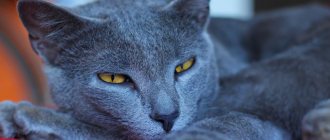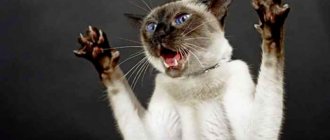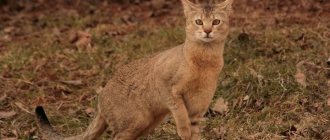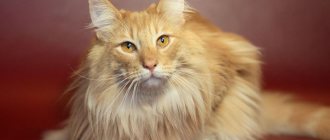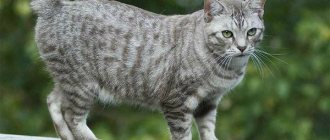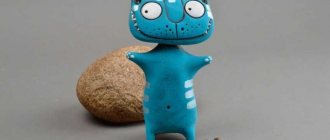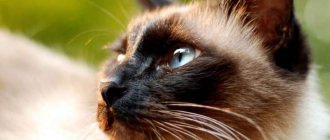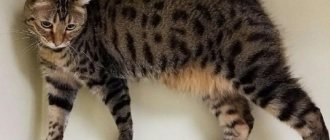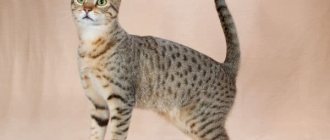The science of breeding cats is involved in breeding a new cat breed or improving the qualities of each type. If a scientist delves into the nuances of breeding, he could be the author of a new type of cat. The breeder's correct approach to work, as well as careful selection of individuals and pairs for crossing, will help to avoid many mistakes and unsuccessful results in the activity.
The essence of cat selection
Selection is the science that studies the creation of new breeds of animals through artificial selection or crossing.
The essence of this teaching is to breed new types of cats, as well as improve the breed characteristics of animals. When crossing individuals using simple methods, both advantages and disadvantages are possible. Thus, with further mating of one breed, the immune abilities of the body may decrease in the offspring. In another species, it is possible that a shortened life span or pathological changes in the activity of the genital organs are possible, which create problems with procreation. For these reasons, feline breeding science is a serious and responsible study. The study of the correct selection of individuals and pairs is considered an interesting work, the optimal results of which bring satisfaction to the scientist and new breeds for lovers of the cat family.
What should you pay attention to?
Before starting practical work on breeding a new breed, breeders spend a long time studying the history and characteristics of the genera that will be crossed. Only after the qualities are fully revealed do scientists begin the practical part of selection. Before crossing cats, the breeder needs to clarify points that require increased attention:
- external characteristics of the cat;
- cat suit;
- behavioral characteristics;
- predisposition to pathological processes;
- ability to procreate;
- distinctive features of the animal's hair.
Return to contents
Maine Coon
Another unusual breed of cat is the Maine Coon. They are distinguished from other breeds by their huge size and rugged appearance. The breed originated in North America. Since Maine Coons evolved naturally (without human intervention), they are perfectly adapted to the cold northern climate. The breed got its name from the American state of Maine and the abbreviation of the English word “racoon” (racoon). The Maine Coon is the official dog of the state of Maine.
Maine Coon: Unsplash
What is the Maine Coon breed standard? The World Cat Federation (WCF) has set a standard for Maine Coons. Here are the basic requirements for the breed:
- large muscular body;
- wide neck and chest;
- a long tail;
- square head;
- ears of a characteristic shape.
The average weight of an adult cat reaches 11 kg, and the longest cat in the world, according to the Guinness Book of Records, the Italian Maine Coon Barivel, has grown to a length of 120 cm.
Breeding methods
After clarifying the characteristics of the breed, the breeder chooses a method of breeding cats. This often depends on the desired outcome. There are such types of reproduction as:
Often animals that are closely related are selected for this purpose.
- The most popular option is selection by phenotype. This method, after breeding the offspring, will improve the appearance of the species and optimize the cat’s coat.
- Improved progeny assessment and kitten health are monitored when breeding by genotype.
- Inbreeding is a method of breeding when specialists choose to cross closely related individuals based on family ties. The disadvantage is the strengthening of existing defects in cats. But the development of new imperfections is excluded.
- Genealogical selection is carried out by including the animal's ancestors in the process. Pedigree cats are often used. In this case, the main final factors are the external data of the cat and its totality of properties received from its ancestors.
For such an event, ideal animals with good health are needed.
After selecting a breeding method, experts consider the selection of individuals for the procedure to be an important point. To improve breed qualities, positive selection of cells with a marker gene is significant. For crossing, breeders select exemplary representatives according to all criteria. But due to the use of a small number of individuals in breeding, selected examples of offspring can lose some qualities and genes. Therefore, they often resort to negative selection. At the same time, all cats of the breed without flaws are used for breeding. In this case, both the phenotype and the genotype are strengthened. When there are many shortcomings in a cat species and a small number of individuals, family crossing is used. It helps preserve the gene pool and thanks to this, the best individuals appear. The method is quite slow and the first positive results appear after 5-10 generations.
A professional breeder must understand the correct selection of both individuals and pairs.
It is important to understand that even in this case, unsuccessful results cannot be ruled out. An unprofessional approach to business will provoke the degeneration of the cat breed. Only complete knowledge about selection, study of the breed characteristics of cats, historical origin and patience will lead to a positive result.
Ragdoll
An American breed of semi-longhaired cat, known for its character and expressive eyes. The name translates from English as 'rag doll'. The breed was developed in the middle of the last century in California. The main selection criterion for the formation of the breed was its exceptionally gentle character. Subsequently, only those cats that could completely relax in a person’s arms were used for selection.
Ragdoll: Wikipedia
What do Ragdoll cats look like? Females reach a weight of 5 kg, males - 8 kg. The head is wedge-shaped, the ears are widely spaced and have tips or tufts. Ragdolls take a long time to grow and become adults only at 3–4 years of age. This breed is dark grey, blue or lilac in color. The main recognizable feature is bright blue eyes.
The most unusual cats are valued for their appearance and friendliness. They are great friends for humans. Unusual color, bulging eyes or lack of hair are unique features of the animal that allow a person to feel like the owner of a wild cat or a fairy-tale animal.
Original article:
A breed of werecats has been developed
Cat breeders have created a breed of cat that looks like a werewolf and behaves like a dog.
. Thanks to a genetic mutation in domestic shorthair cats, the breed, called "Lika", lacks hair around the eyes, nose, ears and face, giving it the appearance of a werewolf.
From the Greek "Lykoi" is translated as " cat-wolf"
". On the rest of the body, their vegetation is unevenly distributed, and in character they are more like a dog.
Cats love to hunt
to everything they find around the house, they are wary of strangers, but quickly soften.
Unlike werewolves, whose personalities change during the full moon, face cats are quite friendly and playful
.
What heritable traits are transmitted by chromosomes?
Genetics is a baby in the scientific world. It is the same cosmos, only inside an individual. To date, scientists have been able to isolate a negligible number of genes responsible only for the simplest traits:
- wool (its color, structure and length);
- shape and location of the ears;
- eye color;
- body anatomy (tail, paws, height).
Diseases are also inherited. They are called genetic. Here are just a few of them:
- cardiomyopathy;
Hypertrophic cardiomyopathy is a hereditary disease that manifests itself in thickening of the walls of the ventricles of the heart, which leads to a decrease in their ability to contract
- porphyria - impaired hemoglobin synthesis;
- meningocele - brain herniation;
- von Willebrand disease - increased bleeding of the mucous membranes;
- retinal atrophy;
- polycystic kidney disease.
New breed of cats (photo)
Producer Johnny Gobble, his wife Brittney and Patti Thomas from Tennessee in the USA said that no human intervention was needed to breed the cat. The gene was a natural mutation
, which appeared in the domestic cat population.
They used kittens from two groups to breed the Lykoi cats, after making sure they were healthy and free of genetic diseases.
Experts discovered that some cat hair follicles lacked all the components needed to create fur. Even if the follicles produced hairs, there was no balance to maintain them and over time they became bald
. However, DNA tests confirmed that these cats did not belong to the hairless Sphynx breed.
In September 2011, the first Lykoy kitten was born, named Daciana.
Now there are about 14 litters of kittens not from the original offspring, and there are 7 registered breeders of this breed in the world.
Japanese Bobtail
Japanese bobtails have the same short tails as rabbits; moreover, some cats themselves jump like rabbits, and do not run like self-respecting cats. In medieval Japan, cats with long tails were for some reason considered to bring bad luck; for this reason, their tails were cut off here for a long time, and local selection was aimed at breeding breeds with a minimum length of these same tails. In 1602, the emperor issued a decree “liberating” cats; now they could be street dogs, but by this time they were already born with short tails, just in case. Japanese bobtails have a variety of coat colors, but the most popular cats are Calico or Mike cats, which have a white background with black or reddish uneven loops.
The most expensive cat breed
Cats are one of the most popular pets in the world. Depending on the rarity and purity of the breed, their price may vary. Here is a list of the most expensive cat breeds:
Maine Coon
Price: about 1000 dollars
This cat breed originated from representatives living in Maine, USA. They are called gentle giants due to their large size. They are distinguished by their friendly, flexible character.
British shorthair cat
Price: 500 – 1500 dollars
One of the popular cat breeds at cat shows. They have a stable character and get along well at home.
History of appearance
Despite the fact that millions of dollars are spent annually on studying felines, there is still no definite answer - when and how did the cat (K) appear in our homes? The approximate date of the appearance of the domestic K, or rather its ancestor - the steppe - is 140 thousand years ago. Being essentially one of the subspecies of the wild forest cat, the steppe, spotted or African K still lives in the steppe, desert and mountainous regions of Africa, Asia, Transcaucasia, Kazakhstan, and India. Artificially bred cat breeds have the genes of their ancestors - wild K. The word “cat” itself comes from Latin. Derived from “captus” or “captat” - smart, bringing prey.
Scottish Fold (Scottish Fold cat)
Price: 200 – 3000 dollars
A distinctive feature of this breed is its downturned ears, and they are also unusually friendly.
Sphinx
Price: 300 – 3000 dollars
One of the most popular cat breeds, it is distinguished by its lack of hair, but requires special care.
Russian blue cat
Price: 400 – 3000 dollars
These cats are known for their playful, curious and intelligent nature. They get along well with other pets and children in the house.
Oriental
The representative of the Siamese-Oriental breed group is the Oriental breed. This is a slender, flexible cat with refined body lines. On the unusual wedge-shaped head there are beautiful expressive eyes and large triangular ears. The nose is long, well defined on a sharp muzzle.
Oriental: Wikipedia
What are Orientals known for? These friendly cats look menacing and intimidating. They are playful and love to travel. The love for games does not disappear until old age. The Oriental is an emotional, “talkative” cat that expresses emotions through playful behavior, purring or meowing in different tones.
Cat breeds (prices)
Peterbald (Petersburg Sphynx)
Price: 1200 – 5000 dollars
Peterbalds are the result of an experimental mating between an Oriental Shorthair cat and a Don Sphynx cat. This is an inquisitive, intelligent, energetic breed with an elegant slenderness and strong build.
Persian cat
Price: 500 – 5500 dollars
A popular breed of long-haired cats with a calm, affectionate character.
Bengal cat
Price: 1000 – 25,000 dollars
This very beautiful cat breed is a mixture of an Asian Bengal cat and a domestic cat. Combines the personality of a dog and a playful nature.
Savannah
Price: $1,500 – $50,000
The Savannah is a cross between a domestic cat and a serval cat. They are often compared to dogs for their loyalty. In addition, they are exceptionally smart.
Asherah
Price: $15,000 – $100,000
The Ashera is a cross between the African Serval, Asian Bengal and domestic cat.
These are smart, loving and loyal cats.
However, the authenticity of the breed has been questioned, and DNA testing of known examples of Asherah cats has shown that they are Savannah cats and are selling for four times their true value.
Munchkin
The Munchkin cat breed also has an unusual appearance due to its short legs. The thing is that their DNA contains the achondroplasia gene. If the munchkin's body length is average for cats, then its paws are 2-3 times shorter, so they are often compared to dachshunds. However, munchkins have more than just a unique appearance. For example, ordinary cats, wanting to look around, stand up on their hind legs. Munchkins act differently - they sit on their “fifth point”, leaning on their tail. They are ready to stay in this position for a long time, and the small front legs hanging on the sides make them look like a kangaroo. Munchkins are the fruit of a spontaneous mutation, and not of targeted selection, so modern experts do not classify them as a separate breed.
How new breeds are created
A new breed of cat or a more advanced type of an existing one is bred by a breeder - a scientist who understands genetics and felinology. His ultimate goal is to obtain animals that have the same genotype and best meet the necessary parameters - breed standards. Breed standards are a set of characteristics of its representative.
To carry out high-quality selection, you need to know the pedigree of the animals selected for breeding. The process of breeding begins with the selection of the first cats.
Suitable cats are crossed, and from their offspring those who have inherited (or perhaps developed) the desired traits are selected for the next stage of breeding. The same is done with the offspring of the second generation. So until you get a representative of the breed that meets all the characteristics in the standard.
Two techniques are used for selection: inbreeding and outbreeding. Inbreeding is the crossing of closely related animals. It is carried out in order to consolidate the necessary qualities and create a stable genotype. Outbreeding is the crossing of animals that have the same characteristics, but which do not have a common ancestor, for 4-6 generations.
In order for a new breed to be recognized by the felinological association, the breeder presents about 20-50 individuals of different sexes and ages. In addition, it is necessary to have documents proving the purebred of the animals.
Selection is a long, costly and largely creative process. Many breeds, like other achievements of human culture, have their own author. Let's talk about some cat breeds bred through careful selection.
Sale of kittens. Tips for breeders
For members of special clubs there is the opportunity to sell directly at exhibitions, as well as disseminate information among other club members.
No less popular is the method of posting advertisements on the Internet, preferably on thematic forums, in groups of lovers of certain breeds of cats.
Nurseries with an already established reputation prefer to advertise their pupils on separate websites. You will have to pay extra for these services, but it is this format that inspires the most confidence among buyers and will attract the maximum profit.
Kitten registration
The owner of a breeding cat must register the offspring no later than one month after birth. All necessary information is submitted to the club, which will then issue metrics.
Joining specialized clubs
The contract for the purchase and sale of cats for breeding, as well as the metric issued by the breeder, gives the new owner the right to register the animal in any club. It doesn’t have to be a parents’ club; you can choose any one that suits you. This is necessary for further participation in exhibitions, without which you will not be able to obtain the right to breed.
Participation in exhibitions
You can take part in exhibitions from 8 months. Before this, you are allowed to act as a third-party spectator, accustoming the kitten to such an atmosphere.
Participation in exhibitions and well-deserved titles will be a good plus when looking for a partner, and will allow you to set a high price for the offspring.
The number of exhibitions in which an animal participates is not regulated. There is usually a fee to participate, with travel costs increasing in some cases.
Sale without breeding rights
Congenital genetic defects or critical non-compliance with breed standards make the animal unsuitable for breeding.
Such kittens are sold with the mark “pat” in the metric; adult animals are often sterilized. This is a necessary measure to stop the attempts of unscrupulous breeders to thoughtlessly replenish the army of stray animals. Breeding costs in this case will not be covered by the sale of kittens that only look a little like the declared breed, so the offspring often turn out to be unnecessary.
Toyger
Who hasn't dreamed of having their own live tiger? At least on the scale of an ordinary cat. Toyger is the embodiment of this dream! The name itself comes from the words “toy” (toy) and “tiger” (tiger). The “toy tiger” was bred by American felinologist-breeder Judy Sugden on the basis of a Bengal and an ordinary domestic tabby cat.
The toyger has a long body with characteristic tiger stripes, shiny short fur and a soft, friendly character. All these qualities were identified and improved as a result of long selection. The International Feline Association recognized the breed in 2007.
Peterbald
Peterbald, or St. Petersburg Sphynx (Peter - “Petersburg”, bald - “bald”) is the result of the work of domestic breeders. Descended from a Siamese-Oriental cat and a Don Sphynx. Officially recognized in 1996. He is considered the most graceful among the existing four Sphynx breeds.
This is a cat who does not like to walk on his own, but loves to communicate. Lack of aggression and sociability are characteristic qualities of both the Peterbald and his ancestors. But what distinguishes him from other Sfixes is his activity, a quality inherited from cats of oriental breeds.
LiveInternetLiveInternet
Today we have the opportunity to stroke, scratch behind the ear and pull the tail of cats that our great-grandmothers never dreamed of. Sometimes, outright refuting natural selection, passionate people successfully engage in artificial selection, fixing random mutations of cat genes or the results of interesting crossings. Sometimes the origin of these animals is connected with unusual stories, where the role of chance is one of the main ones. In general, look when one of them said “meow” for the first time...
Selkirk Rex
Most new cat breeds begin with the birth of one or two special kittens. As was the case with one stray cat from Montana in 1987. Kitty brought five kittens, one of which stood out with dense and curly fur.
The sheep kitten fell into the caring hands of a Persian breeder. A few years later, the breeder brought out a new breed, which was called the Selkirk Rex. This is one of the youngest breeds. Persians, exotics and the British took part in the formation of the breed. Officially recognized only in 1992, it appeared in Russia in the late 1990s. The breed carries the curly coat gene. Cats come in both long-haired and short-haired varieties.
Longhaired Selkirk Rex kittens are born with very curly hair. Then they lose their curliness and restore it only between the eighth and tenth months of life. The coat of the longhaired Selkirk Rex is completely unique, it combines all three hair types, which is why the longhaired Selkirk Rex looks very exotic.
This breed is called differently: poodles, sheep, bear cubs. But everyone who knows them loves them, regardless of their names. These funny funny cats do not leave anyone indifferent. Selkirk Rexes have a docile, peaceful nature. They become attached to people. The character of the Selkirk Rex reflects the characteristics of all the breeds used in their creation.
Scottish lop-eared
In 1961, William Ross found the first known Scottish Fold kitten on a farm near Cupar Angus in Tayside, Scotland, northwest of Dundee. Ross bought one white kitten from the owner, who became the founder of the new breed. What made the kitten unique was his ears, which curled cutely forward and hung down from his head.
The appearance, reminiscent of a bear cub (to some, an owlet), made a strong impression on many American fanciers and judges. The Scottish Fold received show status from the Cat Fanciers' Association (CFA) in 1978. Many of the original Folds had long hair rather than short hair.
Over the past four decades, the Scottish Fold has acquired its own, recognizable type, despite crossing with American and British Shorthair cats. Crossing cats led to disorders of the musculoskeletal system if both parents were fold-eared. Therefore, the breed can only be bred in the heterozygous form, that is, through constant crossings with individuals of this breed without floppy ears, which are also called Scottish Straights.
The impossibility of the breed existing in a homozygous form and the likelihood of harmful consequences of the mutation inclined the leading English felinological organization to ban the breeding of this breed. Thanks to research conducted by geneticists in the USA and breeders who follow these strict guidelines, the breed is in good health.
Ragamuffin
The word "ragamuffin" means "street tramp". Among the ancestors of cats of the same breed are they, the stray Murziks. And the Ragamuffin breed itself, an indoor friendly breed, appeared as an offshoot during the selection of Ragdolls in 1994.
For crossing with ragdolls, outbred cats with Persian, Himalayan, and Siberian genes were used. Their faces were devoid of the distant arrogance characteristic of the same Persians, and the criterion for selection was fluffiness.
It turned out that this fluffiness, elevated to a principle, stimulates this breed to be very kind to people, which moves the latter to tears. Surely, the genes of yard cats, grateful for kindness, also played a role in the formation of the “white race” of homebodies, ragamuffins, freed from the need to hunt.
The character of this breed is calm, smart, playful, affectionate; easily adapt to life in any conditions, love to be in the arms of their owners; do not resist any human actions; are easy to train; gets along with any pets; They don’t know how to defend themselves, they only hide, they have no hunting instincts. Recommended for any family.
Don Sphynx
In 1986, in Rostov-on-Don, a certain learned lady saved a street kitten from injury. While the chosen cat, named Varvara, was growing up, her back was completely peeling. When Varvara mated with the common European Vaska, the litter contained a cub with the same balding characteristics.
He, the founder of the breed, was named Chita. After five years of hybridization, the Russian folk breed “Don Sphynx” appeared, which was recognized throughout the world in 1996. Baldness in these cats is a dominant genetic trait. Therefore, the mutation in sphinxes from Russian Rostov is stronger than in their Canadian colleagues in terms of baldness.
The cat is thermophilic, so it is necessary to keep it in a warm room. Street content is excluded or highly undesirable. Due to increased heat transfer, the Don Sphynx consumes a slightly larger amount of food than other cats.
The cat is non-conflict when kept with children and other animals. There is no characteristic odor, wool does not remain on things. People who are allergic to cat fur have less frequent reactions to the presence of Don Sphynxes. Many sphinxes get used to one owner and remain devoted only to him.
Minskin
Jokers once called the dachshund “a cat dressed up as a dog.” And the cat people thought about it, put their paws on their tails, and brought out a “cat dachshund.” The Minskin breed comes from short-legged Munchkin cats and long-eared hairless Sphynx cats. By crossing two extreme varieties of cats, breeders got a mini-breed with a touchingly terrifying appearance.
Despite their alien appearance, Minskins are very affectionate to their owners and active. Unlike Sphynx cats, these cats have a bit of almost cashmere-like fur that is extremely fun to pet and probably healthy if you're not allergic to aliens.
Representatives of the Minskin breed are distinguished by their liveliness and charm; they are amazingly curious, independent, brave creatures. Cats and Minskin cats are very attached to their owners, it is easier to take them with you on a business trip or on vacation rather than doom them to loneliness in your absence.
In addition, they quickly adapt to new conditions, feel great in transport, and in a new place they are not so curious as to create problems for the owner or themselves. As a reward for your troubles, you will be rewarded with manifestations of tenderness, affection and love.
Ojos Azules
Ojos Azules means “blue eyes” in Spanish. The first representative of this breed, indicated by eye color, was seen in New Mexico, America in 1984. The main thing in Ojos Azules is the color of their cat's eyes; otherwise, only the length of the coat plays a role.
It is believed that all cats of the Mexican blue-eyed breed have one mother, i.e. breeding began with the litter of a certain blue-eyed cat who walked with various yard cats. When the kittens grew up and gave birth to cute offspring, it turned out that blue eyes were a mysterious genetic trait that was passed on to the entire litter.
Only the Virgin Mary of Guadalupe knows where this mutation turned into a breed came from. The gene for blue eyes turned out to be stronger than the genes for color, so blue-eyed kitties from New Mexico come in a variety of colors.
Ojos azules are excellent companions and family animals. They are very balanced, not prone to aggression, friendly and sweet creatures. Animals of this breed have high intelligence, as well as considerable patience. They feel good both in an apartment and in a private house.
Ojos Azules cats easily get along with other household inhabitants, do not conflict, and are often friends with them. They are playful and don't mind entertaining children. Cats of this breed are gentle and affectionate, quickly become attached to their owner, and suffer alone and without attention. They also get used to the new environment well.
Burmilla
There have never been calm moments in the history of Burma, so cats that come from there are perceived as hereditary refugees, paying a purr for good and kindness for a purr.
The Burmilla breed was born by chance, in the house of a rich lady in 1981. One day, madam did not notice how a Persian chinchilla cat fell in love with a Burmese cat. As a result of the interesting kittens, it was decided to make fathers and mothers of a new breed of domestic cats. In 1994, the Burmilla was officially recognized in the highest circles of cat breeders.
The character of the Burmilla has absorbed all the best features: affectionate, gentle, friendly, intelligent. This breed is moderately playful and moderately calm. Many who have this cat at home or have met her in life say “a dog in a cat’s body” because dogs are just as loyal.
It is believed that from the Persian cat she inherited a calm, peaceful character, and from the Burmese she inherited wisdom and intelligence. The only thing that a Burmilla cannot tolerate is loneliness, which is often like death for her. Burmilla loves to “talk”, so you need to communicate with her as often as possible.
Sokoke
This cat owes its purebred name to its historical homeland - the Arabuko-Sokoke forest reserve, located in Kenya. Judging by the accepted version, Sokoke is a product of the late domestication of wild Kenyan cats of a certain savannah exterior and character.
Sokoke were first introduced as domestic cats in 1978. This happened as a result of an accidental turn in international friendship - a resident of Kenya gave two semi-feral kittens to a specialist from Denmark, with whom she was friends. As a result, a breed of long-legged, slender cats of African origin was born.
In 1992, Sokoke was officially recognized in Denmark, after which the whole world learned about it. The International Federation of Cat Fanciers recognized this breed in 1993.
The nature of such cats is independent and at the same time they are very attached to their owners. They are very active and playful, they are also very curious and affectionate. They get along easily with other pets and dogs in particular. Do not be afraid of water treatments at all.
But despite the fact that these cats are generally very easy to domesticate and live well in apartments, they still need walks where they can frolic heartily and thoroughly stretch their paws.
Napoleon
Napoleon? Yes indeed. You were not mistaken... There is such a breed of cats, named after the great commander, Emperor of France Napoleon Bonaparte - a VERY short man who was terribly afraid of cats. Therefore, he would hardly be delighted if he learned that modern breeders decided to immortalize his name in the name of a new breed of cats.
Interestingly, this imperial breed was not bred by a felinologist, but by a dog breeder who breeds basset hounds. On June 12, 1995, American breeder Joe Smith read an article in the Wall Street Journal about little munchkins and was fascinated by these short-legged purrs.
Smith had the idea, based on munchkins, to create a tiny cat of extraordinary beauty, the main feature of which would be miniature and a touching face. Moreover, the length of the legs did not matter much, since within the same breed Smith decided to breed 2 types of cats - with short and long legs, equally in demand and valuable. This is how the classic Napoleon with regular leg length and the short-toed Napoleon extreme (for exotic lovers) were born.
Smith invested a lot of effort, money and time into his idea so that his brainchild would gain worldwide love and official recognition. At some point, he became so desperate that he castrated, sold and gave away the Napoleons he had. And he even destroyed all information on their breeding.
However, the cats were so adorable that Smith's case inspired other breeders. And the Napoleon breed was accepted for registration in TICA (USA) and ASSOLUX (Russia).
Smart, sociable, affectionate and very trusting breed. They don’t understand what aggression is, so children can swaddle the little emperor like a doll and carry him in a stroller. He allows everything! If you take the little Napoleon in your arms, he will go limp, like a rag, saying with all his appearance: “Do with me whatever you want - just love me!”
Toyger
If everything in life has become boring, you can get yourself not even a cat, but a whole tiger. Not quite a toy, but small - you won’t have to go broke feeding it.
The Toyger breed was created so that with its stripes these cats would remind their owners of the owners of the Asian jungle. Well, or mackerel.
Toygers first said their meow in the late 1980s in America and are so-called “designer” cats. The author of the breed is Judy Sugden. The first cats were brought to Russia in 2008. The Toyger breed got its name from the English words: toy (toy) + tiger (tiger) = toyger (toy tiger), i.e. toyger
The breed is still developing, and its defect is considered to be the presence of a “tiger” temperament in a domestic animal. That is, according to the standard, a toyger must be affectionate, even to the point of shyness. This is a very smart animal. They do not require much attention from the owner, but show real devotion. Kittens of this breed are very expensive.
Source
Pixiebob
The cat of this breed is a small domestic lynx. She is affectionate, sociable and active. Pixiebob loves to play, and despite her sometimes threatening appearance as a predator, she is friendly to children.
This breed appeared due to the desire of breeders to get an animal that resembled a domestic lynx. To do this, they crossed domestic cats with wild forest cats. But the task turned out to be difficult: it took a long time to create a pet predator. The pixie bob was officially registered only in 1995, but even today not all felinological organizations recognize this breed.
Sphinx
Perhaps the strangest-looking cat is the Sphynx, which is born completely naked and lives like that all its life. Their skin is completely devoid of hair, and it is also wrinkled. But at the same time, sphinxes are not at all old people, as one might think; they demonstrate high intelligence, are energetic, curious, and attached to their owners. But within the breed there are different sphinxes. For example, a hybrid of the Canadian Sphynx and the American Curl gave us elves - a hairless cat with curled ears. And there is also the St. Petersburg Sphynx, the Don Sphynx, fold-eared Ukrainian Levkoys with almond-shaped eyes and other options.
10 rarest animals in the world from the Red BookThe World Wildlife Fund is sounding the alarm: over the past 40 years, the number of animals on the planet has decreased by 60%. The main reasons for their extinction &ndas...
Exotic
Love Persian cats but don't like long hair? Exotic is what you need! Cute face, big eyes and luxurious, thick but short fur. Breeders used short-haired breeds to breed exotics, which were crossed with Persians. This slow, calm and affectionate cat loves to sleep a lot.
The exotic appeared due to a curious accident: its creators wanted to breed an American shorthair cat of new colors and crossed it with a silver Persian. As a result, the opposite happened: instead of a silver American, we got a short-haired Persian.
American Curl
American Curls are similar to the most common cats, but with one important difference - their ears have a unique shape. This ear shape is also the result of a spontaneous genetic mutation, which is a natural phenomenon. The ears of American Curl kittens are straight from birth, but after 2-10 days they begin to gradually curl, and by 4 months they acquire their final shape. The tips of their ears become flexible and rounded, and they curl at an angle of 90 to 180 degrees. This looks like a rather strange cat. Now there are many of them all over the world - from the USA they moved to Japan, France, Spain, Russia and other countries. American Curls are playful, friendly, not too whimsical, and easily adapt to changing environments. Since they love to play, they need space and all kinds of toys. But it is better not to have them for families with small children, because children who love to cuddle animals can cause painful injury to the Curl.
